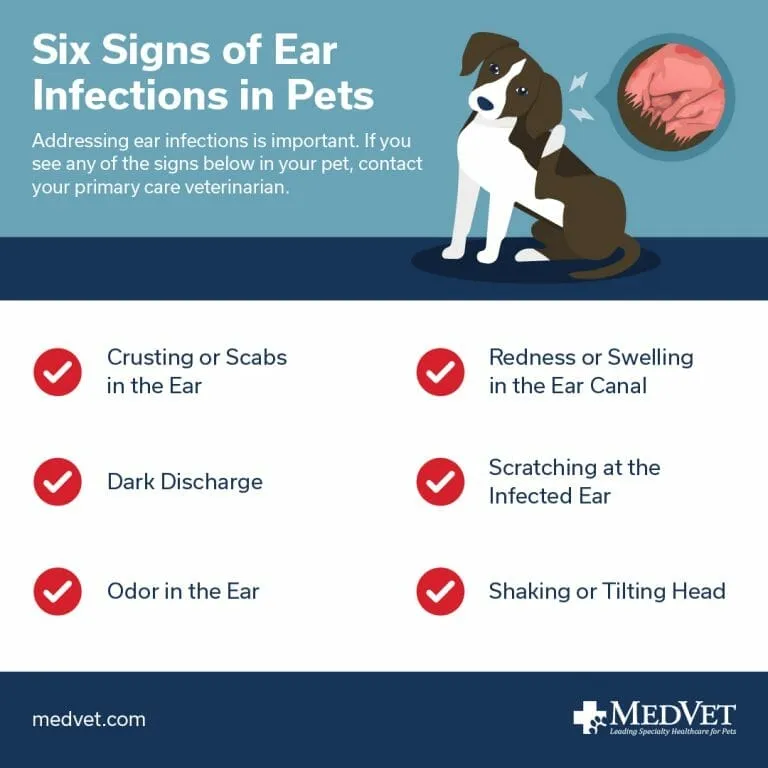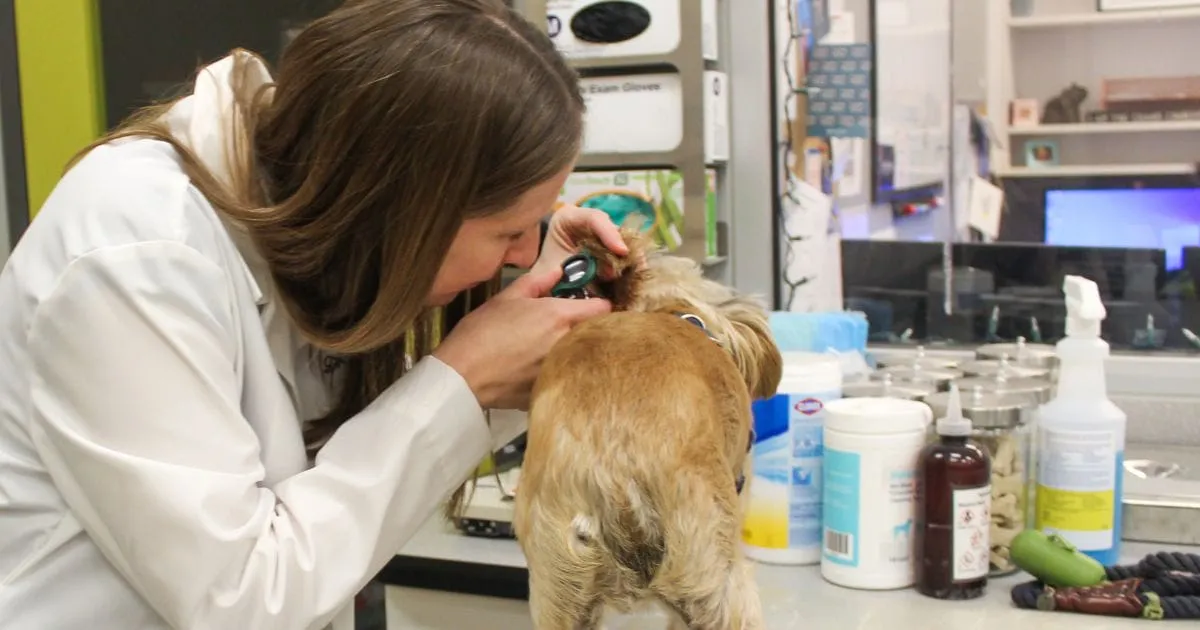Ear infections are a common and often painful ailment for dogs, causing significant discomfort. Just like in humans, recurrent or persistent ear infections in dogs often indicate an underlying primary condition that triggers inflammation and promotes the overgrowth of yeast or bacteria. Potential culprits include primary allergic diseases, the presence of a foreign body, polyps or masses, endocrine disorders, and autoimmune skin conditions. Certain grooming practices, such as excessive hair plucking or the misuse of cotton swabs, along with frequent swimming and specific breed predispositions, can increase a dog’s susceptibility to ear infections. Over time, chronic inflammation can lead to structural changes in the ear canal, the development of bacterial biofilms, drug-resistant infections, and even spread to the middle ear, complicating effective treatment. In many cases, Steroid Ear Drops For Dogs become a crucial component of a comprehensive treatment plan to manage the painful inflammation associated with these conditions.
What Are Steroid Ear Drops and How Do They Work?
Steroid ear drops for dogs typically contain corticosteroids, powerful anti-inflammatory medications. These drops work by reducing inflammation, swelling, and itching within the ear canal. By calming the inflammatory response, steroid ear drops help alleviate discomfort and create a less hospitable environment for opportunistic pathogens like yeast and bacteria to thrive. They are often prescribed in conjunction with other medications, such as antibiotics or antifungals, to address the root cause of the infection while managing symptoms. These specialized [medicated ear drops for dogs](https://dogcarestory.com/medicated-ear-drops-for-dogs/) are a cornerstone in veterinary dermatology for resolving painful ear issues.
Recognizing the Signs Your Dog Might Need Steroid Ear Drops
If your dog is experiencing an ear infection, you will likely observe one or more of the following signs:
- Excessive scratching at the affected ear or rubbing their face.
- Frequent head shaking, ear rubbing, or a persistent head tilt.
- Noticeable redness or swelling in the ear canal or on the ear flap (pinna).
- Crusting or scabs around the ear opening.
- An abundance of ear wax, often appearing darker than usual.
- Purulent discharge or pus of any color.
- An unpleasant odor emanating from the ear.
- Dark brown, waxy, or slimy discharge.
If you notice any of these symptoms, it’s essential to consult your family veterinarian promptly for proper diagnosis and treatment. Early intervention can prevent the condition from worsening and ensure your dog receives the most effective [ear infection meds for dogs](https://dogcarestory.com/ear-infection-meds-for-dogs/).
 Close-up of a dog's red, inflamed ear showing signs of a severe ear infection, potentially requiring steroid ear drops.
Close-up of a dog's red, inflamed ear showing signs of a severe ear infection, potentially requiring steroid ear drops.
Understanding the Causes of Dog Ear Infections
Ear infections are primarily caused by inflammation and subsequent overgrowth of yeast and/or bacteria. In some cases, such as allergic otitis, severe inflammation may be present even without an active infection. These inflammatory responses can lead to a cycle of discomfort, which [anti itch meds for dogs](https://dogcarestory.com/anti-itch-meds-for-dogs/) or steroid ear drops can help break.
There are three main types of ear infections:
- Otitis externa (OE): Infection of the external ear canal.
- Otitis media (OM): Infection of the middle ear.
- Otitis interna (OI): Infection of the inner ear or brain.
This article primarily focuses on Otitis externa, as this is where topical steroid ear drops for dogs are most frequently utilized.
Diagnosis: When Vets Prescribe Steroid Ear Drops
When you bring your dog to the vet for suspected ear issues, their care team will gather a complete history, asking about the signs your pet is displaying, how long they’ve been present, which ears are affected, and if any neurological symptoms are observed.
Your veterinarian will use an otoscope to examine each ear canal down to the eardrum (tympanic membrane). This allows them to inspect the ear canal for foreign material and assess the eardrum’s condition. They may also recommend diagnostic tests to identify yeast, bacteria, parasites, or other underlying issues. Imaging studies might be suggested if middle or inner ear involvement is suspected.
If your dog is in too much pain or the ear canal is severely swollen, a thorough otoscopic evaluation might not be possible during the initial visit. In such cases, your veterinarian may prescribe an oral steroid for a few days to reduce inflammation and open the ear canal, making subsequent examination and topical treatment with steroid ear drops for dogs feasible. Pain medication may also be prescribed to improve your dog’s comfort.
 Veterinary dermatologist using an otoscope to examine a dog's ear canal for infection and inflammation, crucial before prescribing steroid ear drops.
Veterinary dermatologist using an otoscope to examine a dog's ear canal for infection and inflammation, crucial before prescribing steroid ear drops.
Administering Steroid Ear Drops: Tips for Dog Owners
Once your veterinarian prescribes steroid ear drops for dogs, it’s crucial to administer them correctly for maximum effectiveness. Always follow your vet’s specific instructions regarding dosage and frequency.
Here are some general tips for applying ear drops:
- Warm the Drops (Optional): Gently warm the bottle of ear drops in your hands for a few minutes before administration to make them more comfortable for your dog.
- Position Your Dog: Have your dog in a comfortable, relaxed position. You may need a second person to help gently hold their head still.
- Clean the Ear: If your vet recommended an ear cleaner, use it before the steroid drops. Wait the recommended time (usually 10-15 minutes) for the cleaner to work and then gently wipe away any debris.
- Administer the Drops: Hold the ear flap up and outward to straighten the ear canal. Carefully insert the dropper tip into the opening of the ear canal and dispense the prescribed number of drops. Avoid touching the dropper tip to the ear to prevent contamination.
- Massage the Ear: Gently massage the base of the ear for 30 seconds to help distribute the medication deep into the ear canal. You might hear a squishing sound, which is normal.
- Praise and Reward: Always offer praise and a treat after administering the drops to create a positive association.
Treatment durations can vary from seven to thirty days, depending on the severity of the infection and your dog’s response to the [best medicine for ear infection in dogs](https://dogcarestory.com/best-medicine-for-ear-infection-in-dogs/). Oral steroids are rarely used for external ear canal infections unless specific bacteria are present, or there’s an ulcerated ear canal or topical reaction.
Diagnosing and Treating Middle Ear Infections (OM)
If your dog experiences chronic ear infections or exhibits neurological signs, your family veterinarian may refer you to a veterinary dermatologist for further evaluation. Diagnosing Otitis media (OM) typically requires anesthesia for advanced imaging, such as a CT (Computerized Tomography) scan, MRI (Magnetic Resonance Imaging), or video-otoscopy (VO) using an ear camera. A myringotomy procedure, involving a puncture in the middle ear to sample fluid for culture and flush out debris, may also be performed. The culture results guide the prescription of a medication specific to your dog’s needs, which often includes [antibiotic ear drops for dogs](https://dogcarestory.com/antibiotic-ear-drops-for-dogs/) along with oral and systemic topical medications for one to three months. Regular follow-up appointments with the veterinary dermatologist are crucial to monitor healing and treatment response. If a mass is detected, advanced imaging can help in biopsy or surgical removal using specialized tools or lasers.
Preventing Recurrent Ear Infections in Dogs
Preventing ear infections is key to your dog’s long-term ear health.
- Regular Cleaning: Keeping your dog’s ears clean with a veterinary-approved cleaner is the most effective way to remove debris and dirt that could lead to infection.
- Avoid Dampness: It’s important to keep your dog’s ears dry, especially after swimming or bathing, as damp environments increase the risk of ear infections.
- Routine Vet Check-ups: Regular visits to your family veterinarian are essential to ensure their ears remain healthy and infection-free. If your pet requires specialized care for their ear infections, don’t hesitate to ask your vet for a referral to a veterinary dermatologist.
Conclusion
Ear infections in dogs, while common, require prompt and appropriate veterinary attention to prevent progression and alleviate discomfort. Steroid ear drops for dogs play a vital role in managing the inflammation and pain associated with these conditions, often alongside other targeted medications like antibiotics or antifungals. Understanding the signs, causes, and diagnostic processes is crucial for every dog owner. By working closely with your veterinarian, following treatment protocols carefully, and implementing preventive measures, you can help ensure your dog’s ears remain healthy and comfortable. Always consult your vet for an accurate diagnosis and the most effective treatment plan tailored to your dog’s specific needs.
References
- American Veterinary Medical Association (AVMA)
- American College of Veterinary Dermatology (ACVD)
- Merck Veterinary Manual
